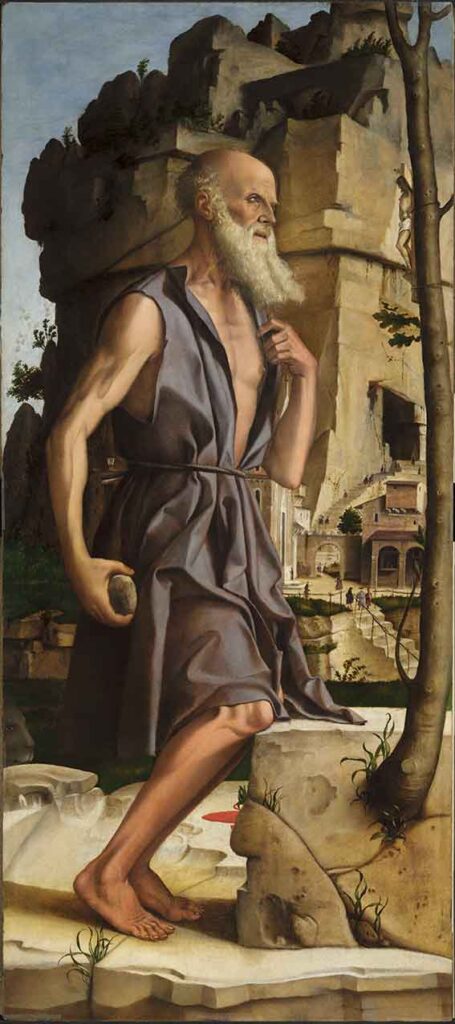Saint Jerome
Bartolomeo Montagna , 1482
Description

This work, datable to 1482, was bought by Gian Giacomo Poldi Pezzoli together with its pendant representing Saint Paul ( inv. 1605). The two panels were probably part of a polyptych, which had at its center a Virgin and Child. These are two of the masterpieces by Bartolomeo Montagna, active Vicenza from the 1470s to the first decades of the next century and considered at that time the most prestigious artist in the city. Saint Jerome is represented full-length, half-kneeling in front of the cross, which is tied to an oak, Christian symbol of salvation and steadfastness in faith; in his hand he holds the stone with which he used to beat his breast. Behind him, against a rock there are some buildings with stairways peopled with small figures
Saint Paul stands out against a light-blue sky with clouds, and a city with Renaissance-style architectures in the background. The two works are striking for the monumentality of the figures, enhanced by the lowered point of view, placed at the height of the saints’ knees, and for the sculptural quality emphasized, by the draperies, especially Saint Paul’s ones.
Remarkable elements in the two panels are also the naturalistic rendering of details and the use of light, strongly influenced by the knowledge of Giovanni Bellini’s works. It is a sunny light that harmonizes in a warm tone the colours of the flesh, the draperies, and the landscape.
Data Sheet
Author
Bartolomeo Montagna, 1450 ca.- 1523
Date
1482
Material and technique
Tempera on panel
Measures
112.3 cm x 50 cm
Acquisition
Gian Giacomo Poldi Pezzoli bequest, 1879
Inventory number
1582
location
Golden Room
The Golden Room is the most important room in the Museum and houses the masterpieces of painting from the Poldi Pezzoli collection. Conceived according to the dictates of the Renaissance style, it was designed to be the hall of honor of Gian Giacomo’s apartment. After the collector’s death, Giuseppe Bertini carried on the work: unfortunately, both the gilded coffered ceiling, the frescoes, painted by Bertini himself, and the damask fabric decorations that lined the walls were destroyed by bombing. The current museographic arrangement dates back to the 1990s. Among the works on display are the Portrait of a Lady attributed to Piero del Pollaiolo and which has become a symbol of the museum, Bellini’s Imago Pietatis, Botticelli’s Lamentation over the Dead Christ, Mantegna’s Madonna and Child, and Piero della Francesca’s Saint Nicholas of Tolentino. The display case separating the Salone Dorato from the Sala degli Stucchi houses the porcelain and majolica collections.
collection
Paintings
The Museum hosts over 300 paintings. Among them, many Italian works from the Renaissance: masterpieces from Tuscany (Botticelli, Piero della Francesca, Pollaiuolo), Lombardy (Luini, Boltraffio, Solario) and Veneto (Bellini, Mantegna). Important is also the group of 18th century Italian painting (Guardi, Canaletto, Tiepolo, Fra Galgario). In the collection, there are mainly portraits and small size paintings.
